The HGST Ultrastar SSD800MM enterprise SSD is the second 12Gb/s SAS interface SSD available on the market and features co-developed Intel/HGST controller and 25nm MLC NAND. The SSD800MM, which as the name indicates offers up to 800GB of capacity, fits into a new family of drives presented by HGST. The other SSDs in the series are the SSD800MH and SSD1000MR, and the whole line has been designed with the most demanding applications in mind such as big data analytics, high-frequency trading, online banking and cloud computing. On top of that, the SSD800MM is designed to be energy efficient with an option to select between 9W or 11W of power consumption to leverage energy efficiency or performance.
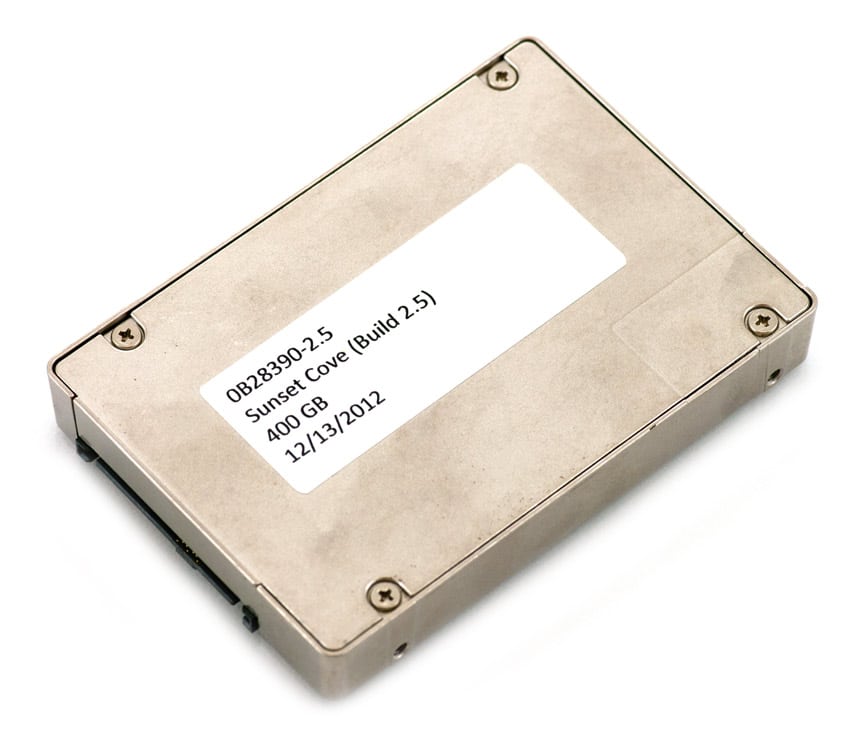
The three drives in the new 12Gb/s SAS family diverge most prominently both when it comes to endurance and performance. The Ultrastar SSD800MM that we are reviewing is rated with endurance at up to 10 full drive writes per day (DW/D) for five years, while the greatest endurance model SSD800MH is rated at 25 DW/D and the budget-conscious SSD1000MR is rated at 2 DW/D. Aside from this, the SSD800MM is also rated for as much as 14.6PB written versus 36.5PB on the SSD800MM. It’s not just endurance that separates these cutting-edge SSDs from one another. Read and write respective IOPS are as follows: SSD800MH – 145,000/100,000; SSD800MM – 145,000 IOPS/70,000 write; SSD1000MR – 145,000/20,000.
As we discussed in our review of the Toshiba PX02SM SSD, that drive and the SSD800MM are leaping out of the gates early as SAS 12Gb/s HBAs are still yet to hit the market. That means that for now, some performance will be limited by the drives utilizing backwards compatibility via SAS 6Gb/s, though throughput via that interface will still be strong. HGST says that 6Gb/s users will still get small block performance enhancements, and when market availability brings full 12Gb/s utilization, large block transfers will be even more impressive.
HGST is also offering their Ultrastar 12Gb/s SAS SSD800MM with different flavors of encryption or none at all. Organizations will not only have the option, but they also can select Trusted Computing Group (TCG) encryption, TCG + FIPS 140 encryption, or they can elect to have crypto sanitize functionality to securely wipe the drive.
The HGST Ultrastar SSD800MM is available now and comes with a five year warranty with up to 36.5PB written.
HGST Ultrastar SSD800MM Specifications
- Capacities
- 200GB (HUSMM8080ASS200)
- 400GB (HUSMM8040ASS200)
- 800GB (HUSMM8020ASS200)
- The final number indicates whether the drive features Crypto sanitize (0), TCG encryption (1), No encryption (4), or TCG + FIPS Certified Encryption (5)
- NAND: 25nm MLC
- Interface: SAS 6Gb/s and 12Gb/s
- Performance
- Sequential Read (Sustained): 1150MB/s
- Sequential Write (Sustained): 700MB/s
- Random Read 4k (IOPS): 145,000
- Random Write 4k (IOPS): 70,000
- Environmental
- Ambient Temperature: 0° to 60°C
- Shock (half-sine wave): 1000G (0.5ms); 500G (2ms)
- Vibration, random (G RMS): 2.16, all axes (5-700 Hz)
- Endurance TBW: 9.1PB (200GB), 18.3PB (400GB), 36.5PB (800GB)
- MTBF: 2 Million Hours
- Dimensions (WxDxH): 70.1mm x 100.6mm x 15.0mm
- Weight: 70g
- 5-year Limited Warranty
Design and Build
As with a majority of high-performance enterprise SSDs, the Ultrastar SSD800MM comes in a 2.5″ form factor at a 15mm height. The exterior design is no-frills with a lasting solid metal build.
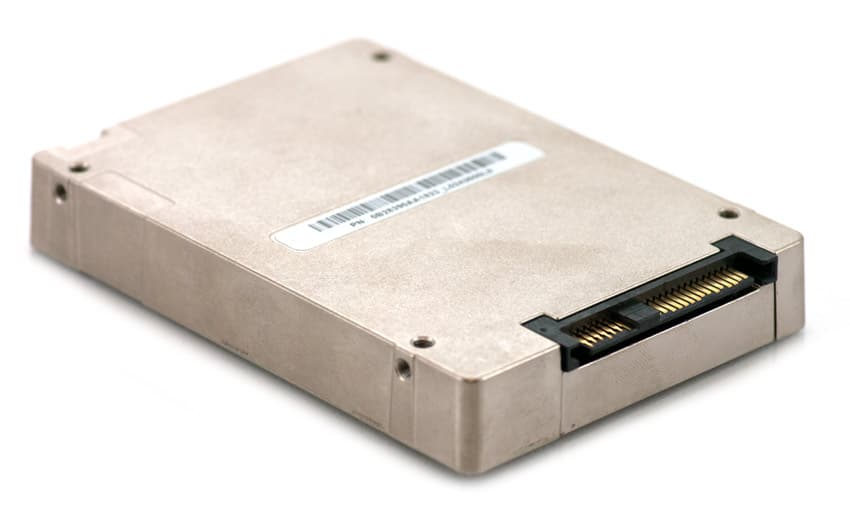
On the front of the SSD800MM is the industry-standard SAS connection for power and data, which is compatible with SAS 12Gb/s and backward-compatible with SAS 12Gb/s.
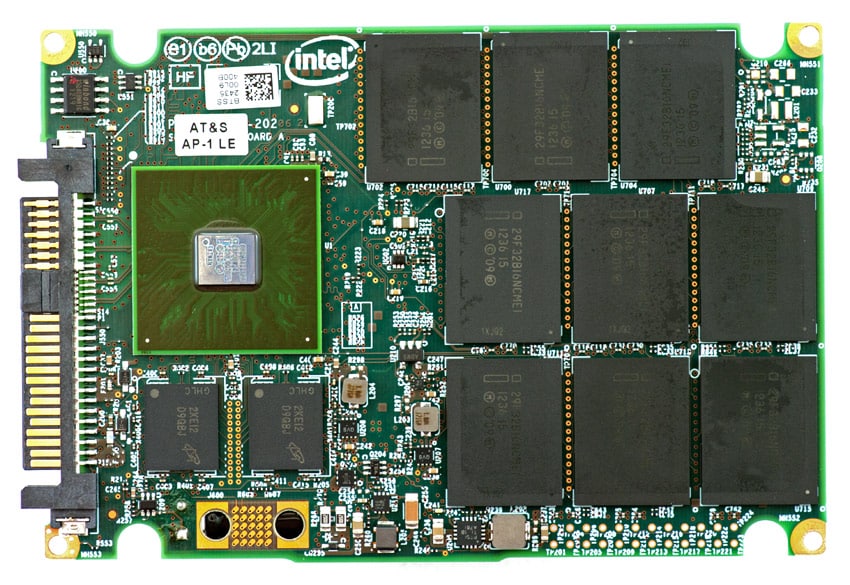
Inside, there is an Intel co-branded DB29AA11B0 SAS 12Gb/s controller. Our 400GB review model also has 18 Intel MLC NAND die packages, each with a capacity of 32GB. The drive’s raw capacity is thus 576GB and its unformatted capacity is 400GB.
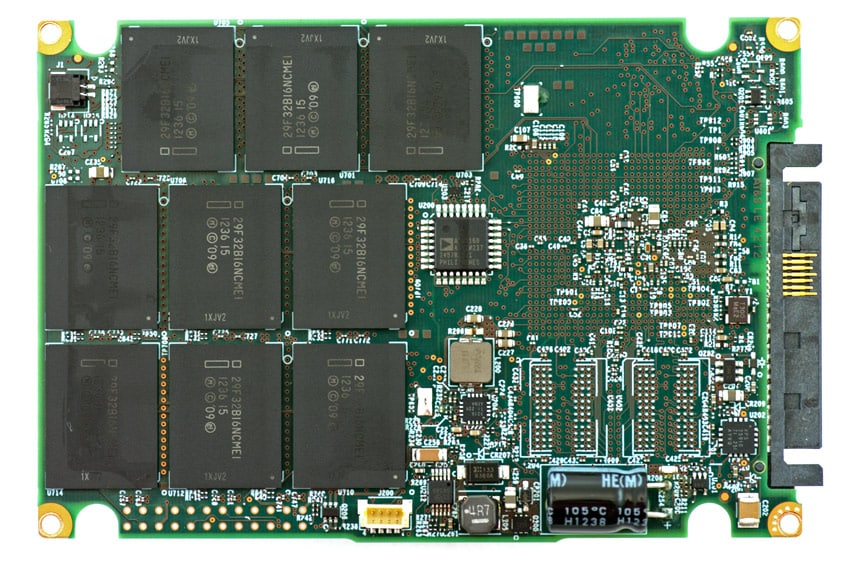
Testing Background and Comparables
The HGST Ultrastar SSD800MM uses an Intel co-branded DB29AA11B0 controller and 25nm MLC NAND with an interface that supports SAS 12Gb/s. In this review we show SAS 6Gb/s performance on our stabilized ThinkServer RD630 platform utilizing an LSI 9207-8i HBA as well as early SAS 12Gb/s performance utilizing a beta sample of a new 9300-8e HBA with a custom cable.
Comparables for this review:
- Toshiba PX02SM (400GB, Marvell co-branded TC58NC9036GTC controller, Toshiba 24nm eMLC NAND, 12Gb/s SAS)
- Toshiba MKx001GRZB eSSD (400GB, Marvell 88SS9032-BLN2, Toshiba 32nm SLC NAND, 6.0Gb/s SAS)
- OCZ Talos 2 C (480GB, SandForce SF-2282 controller, Intel 25nm MLC NAND, 6.0Gb/s SAS)
- OCZ Talos 2 R (400GB, SandForce SF-2500 controller, Intel 25nm MLC NAND, 6.0Gb/s SAS)
- Hitachi SSD400M (400GB, Intel EW29AA31AA1 controller, Intel 25nm eMLC NAND, 6.0Gb/s SAS)
- Smart Optimus (400GB, third-party controller, Toshiba 34nm MLC NAND, 6.0Gb/s SAS)
- STEC s842 (s840 series) (800GB, STEC 24950-15555-XC1 controller, Toshiba MLC NAND, 6.0Gb/s SAS)
All SAS/SATA enterprise SSDs are benchmarked on our second-generation enterprise testing platform based on a Lenovo ThinkServer RD630. This new Linux-based testing platform includes the latest interconnect hardware such as the LSI 9207-8i HBA as well as I/O scheduling optimizations geared towards best-case flash performance. For synthetic benchmarks, we utilize FIO version 2.0.10 for Linux and version 2.0.12.2 for Windows.
- 2 x Intel Xeon E5-2620 (2.0GHz, 15MB Cache, 6-cores)
- Intel C602 Chipset
- Memory – 16GB (2 x 8GB) 1333Mhz DDR3 Registered RDIMMs
- Windows Server 2008 R2 SP1 64-bit, Windows Server 2012 Standard, CentOS 6.3 64-Bit
- 100GB Micron RealSSD P400e Boot SSD
- LSI 9211-4i SAS/SATA 6.0Gb/s HBA (For boot SSDs)
- LSI 9207-8i SAS/SATA 6.0Gb/s HBA (For benchmarking SSDs or HDDs)
- LSI 9300-8e SAS/SATA 12.0Gb/s HBA (For benchmarking early SAS 12 SSD or HDD)
- Mellanox ConnectX-3 10GbE PCIe 3.0 Adapter
- Mellanox ConnectX-3 InfiniBand PCIe 3.0 Adapter
This review covers a limited scope of the SSD800MM’s performance in SAS 12Gb/s mode since the early LSI MPT3SAS driver’s needed for the 9300-8e wouldn’t work on any of our enterprise testing platforms (four different server vendors) in CentOS 6.2 or CentOS 6.3. We did get the drivers to function under a Windows Server 2012 environment, which we used to gather synthetic performance data for the SAS 12Gb/s segment of this review. As such the results aren’t completely apples to apples and should be viewed as a technology preview, not final performance data as the LSI card is obviously not a final product and there will likely be many software reviews between now and general availability of the LSI 12Gb/s SAS HBAs.
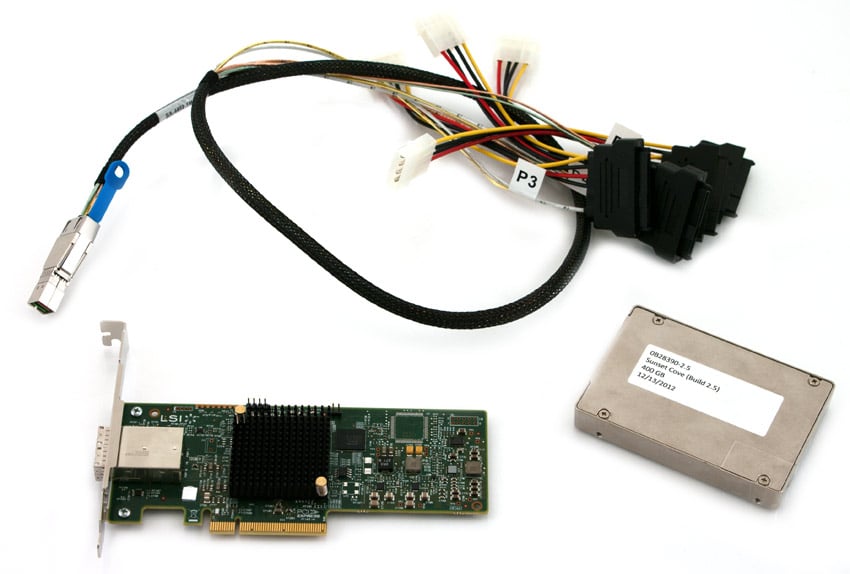
Enterprise Synthetic Workload Analysis
Flash performance varies throughout the preconditioning phase of each storage device. Our enterprise storage benchmark process begins with an analysis of the way the drive performs during a thorough preconditioning phase. Each of the comparable drives are secure erased using the vendor’s tools, preconditioned into steady-state with the same workload the device will be tested with under a heavy load of 16 threads with an outstanding queue of 16 per thread, and then tested in set intervals in multiple thread/queue depth profiles to show performance under light and heavy usage.
Preconditioning and Primary Steady-State Tests:
- Throughput (Read+Write IOPS Aggregate)
- Average Latency (Read+Write Latency Averaged Together)
- Max Latency (Peak Read or Write Latency)
- Latency Standard Deviation (Read+Write Standard Deviation Averaged Together)
Our Enterprise Synthetic Workload Analysis includes four profiles based on real-world tasks. These profiles have been developed to make it easier to compare to our past benchmarks as well as widely-published values such as max 4k read and write speed and 8k 70/30, which is commonly used for enterprise drives.
- 4k
- 100% Read or 100% Write
- 100% 4k
- 8k 70/30
- 70% Read, 30% Write
- 100% 8k
Our first test measures 100% 4k random write performance with a load of 16T/16Q. In this setting, the bursting nature of the HGST Ultrastar SSD800MM 12Gb/s tested as high as 106,000 IOPS, which then leveled off around 65,000 IOPS as the drive neared steady-state. Both figures were far ahead of the competition. The 12Gb/s interface made a substantial difference (35,000 IOPS) in burst performance for the HGST drive, but not the Toshiba PX02SM.
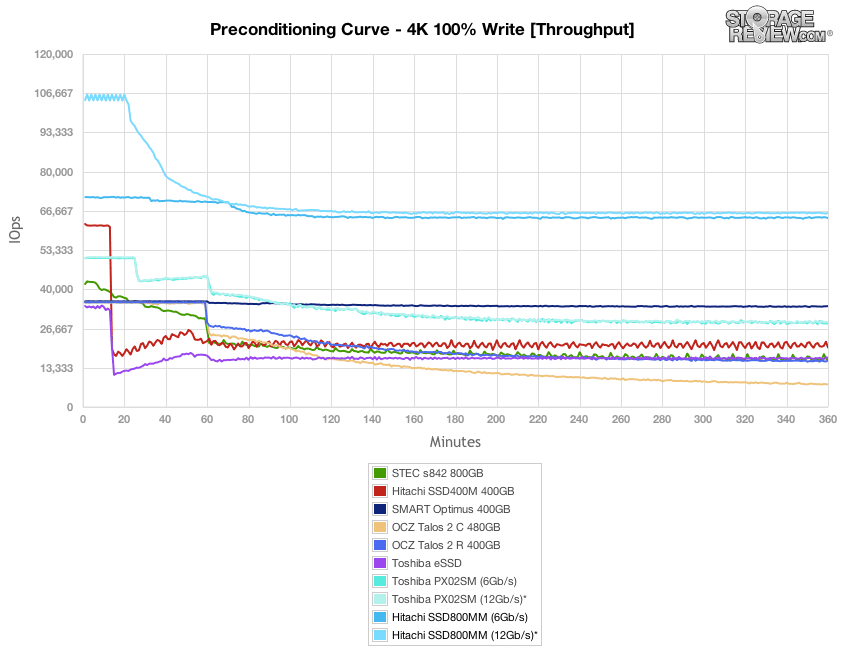
With a heavy 16T/16Q load, the HGST Ultrastar SSD800MM measured 2.45ms in burst and scaled up to around 3.9ms as it neared steady-state. These marks again left the competition behind, and again the 12Gb/s SAS interface proved to make a difference in burst mode for the HGST.
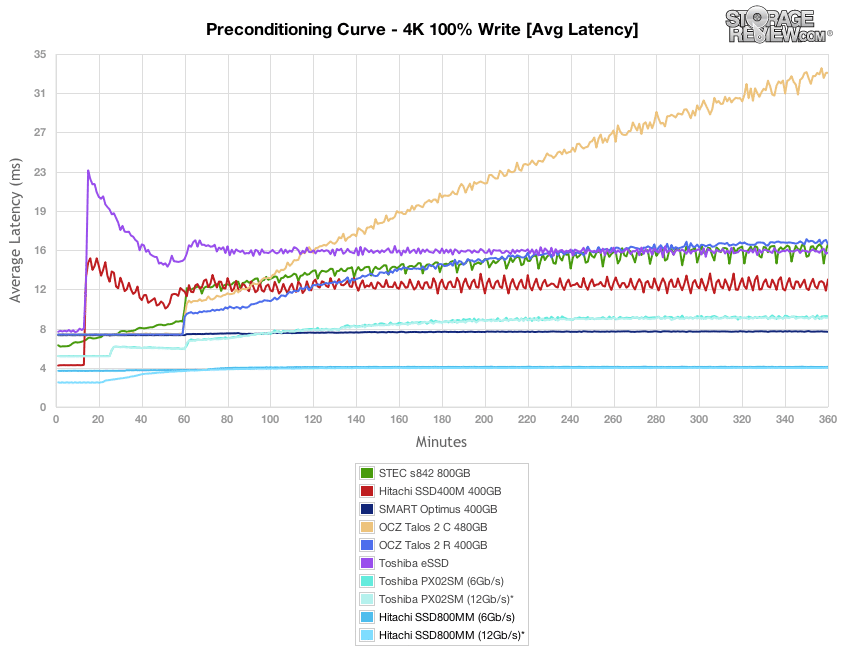
Comparing max latency between the SSDs, the HGST Ultrastar SSD800MM had max response times ranging 16-24ms in steady-state. That range was superior to the competition as was the steady-state range. The SSD800MM over 6Gb/s SAS produced about 10ms greater latency. Also, for max latency the Toshiba PX02SM produced about half the latency with 12Gb/s interface compared with itself in 6Gb/s.
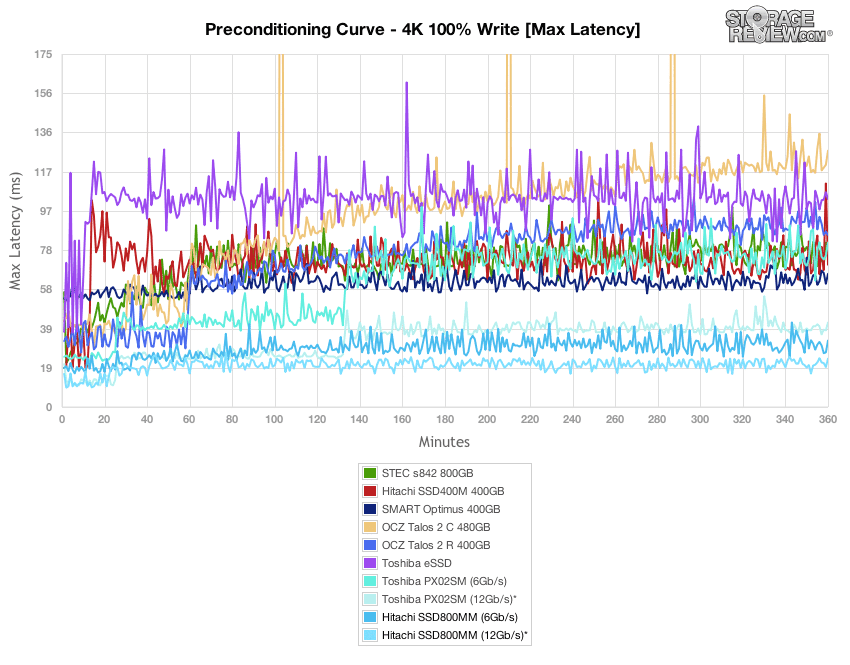
Looking even closer at the latency consistency in our 4k random write workload, the HGST Ultrastar SSD800MM 12Gb/s placed first around only 1.2ms, while the Toshiba PX02SM 12Gb/s was closer to 3.5ms. Both drives produced half of the deviation as with 6Gb/s.
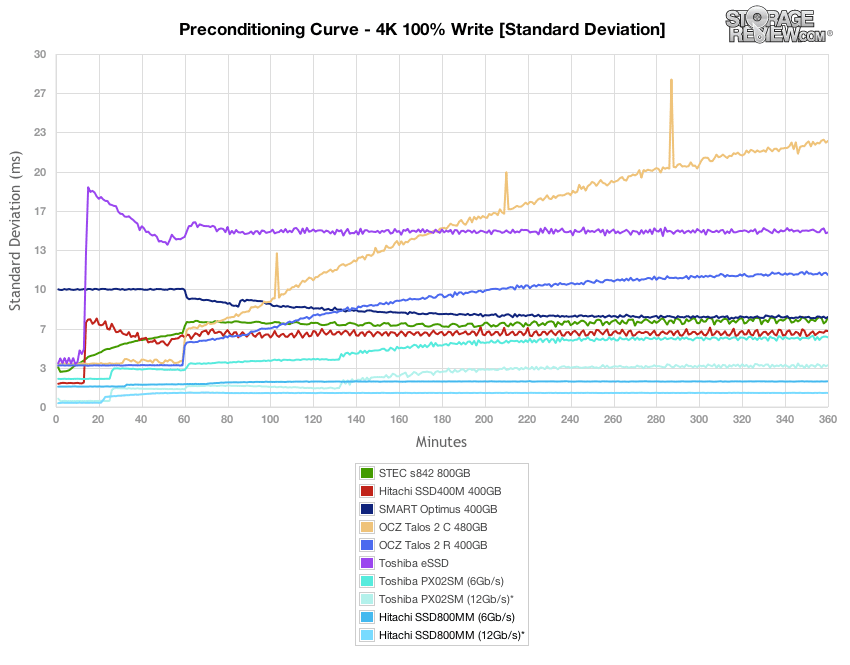
After 6 hours of preconditioning, the HGST Ultrastar SSD800MM 12Gb/s offered 4k random read performance at a class-leading 149,697 IOPS with write activity at 65,272. Again, the SSD800MM produced the top figures. This time, the 12Gb/s testing yielded far greater read IOPS, but similar write IOPS.
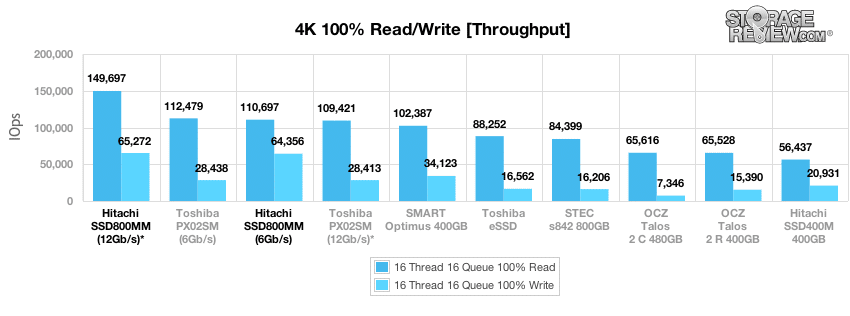
With a workload of 16T/16Q, the HGST Ultrastar SSD800MM 12Gb/s offered an average 4k random read latency of 1.71ms, with a write latency of 3.92ms. The 12Gb/s provided 0.5ms less read activity average latency and 5ms less for write activity. The Toshiba PX02SM performed at almost the same marks over 12Gb/s and 6Gb/s.
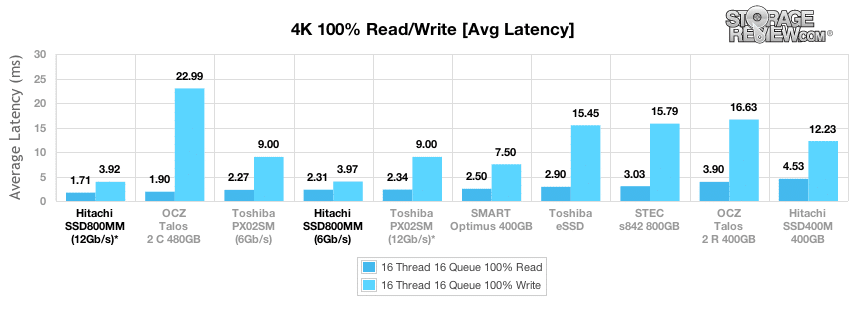
For max latency, the HGST Ultrastar SSD800MM 12Gb/s was dethroned with back of the group read activity marks and middle of the group writes. The 6Gb/s actually performed better. This time the Toshiba PX02SM 12Gb/s produced about less than half the latency of the 6Gb/s testing.
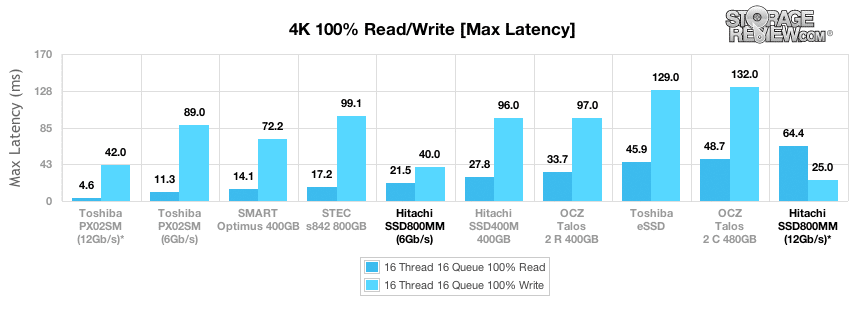
Comparing latency consistency, the HGST Ultrastar SSD800MM posted the strongest figures in 4k random read and write consistency along with the Toshiba PX02SM. Both drives benefited greatly here from the 12Gb/s interface; they produced nearly 0 standard deviation latency for read activity.
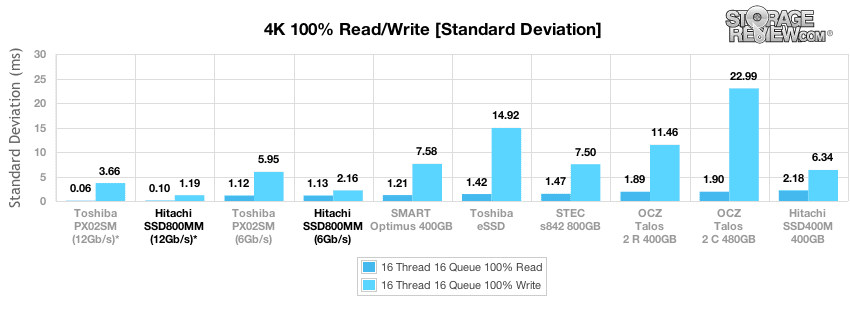
In our next workload we look at an 8k profile with a 70/30 read/write mixed ratio. In this setting, the HGST Ultrastar SSD800MM 12Gb/s produced the greatest throughput starting off around 95,000 IOPS burst which slowed to a speed around 64,000 IOPS near steady-state. The burst performance provided about 40,000 more IOPS than 6Gb/s, though as with our 4k testing, the gap narrowed quite a bit in steady-state. There, 6Gb/s was 10,000 IOPS behind. The Toshiba PX02SM 12Gb/s advantage was more modest at around 4,000 IOPS.
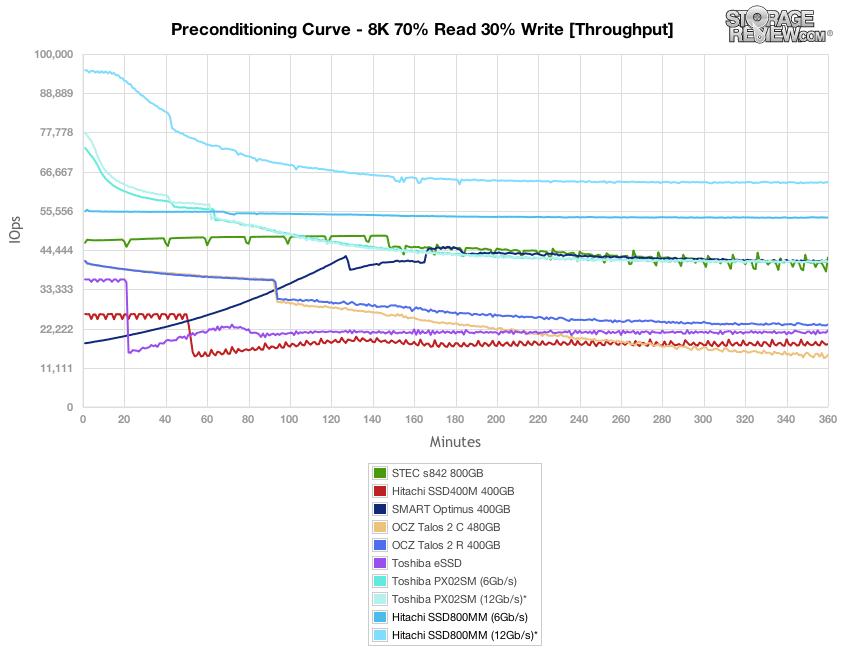
Average latency of the HGST Ultrastar SSD800MM 12Gb/s measured 2.67ms at the beginning of our 8K 70/30 preconditioning test, which increased to around 4.02ms as it neared steady-state. The delta between those class-best figures and the 6Gb/s was noticeable, though the Toshiba PX02SM ratings were similar to one another.
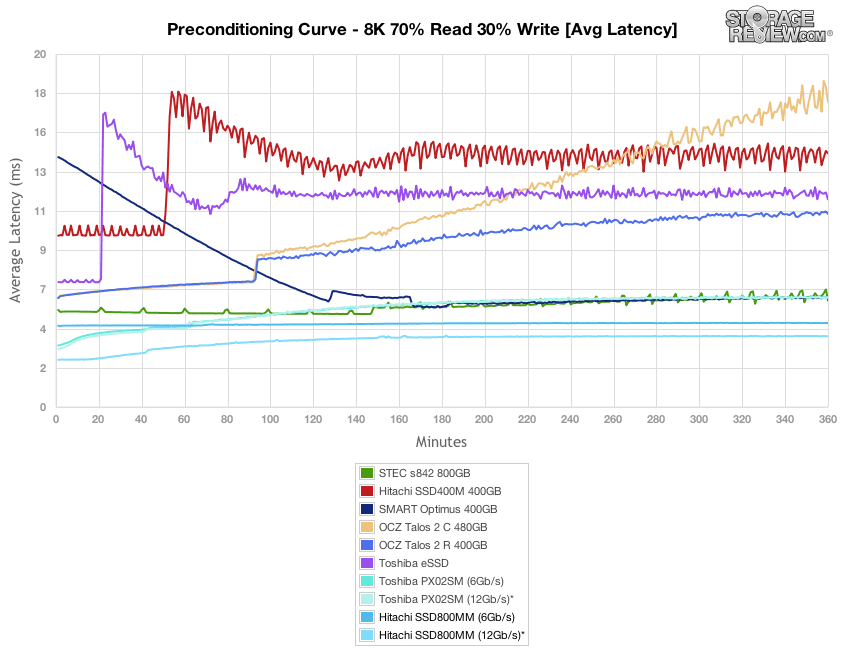
Over the duration of our 8k 70/30 test, the HGST Ultrastar SSD800MM 12Gb/s and the Toshiba PX02SM crisscrossed one another and delivered the best peak response times. Their max latency measured below 20ms for the bulk of the test. Their 12Gb/s SAS interfaces proved to yield about 40% less latency.
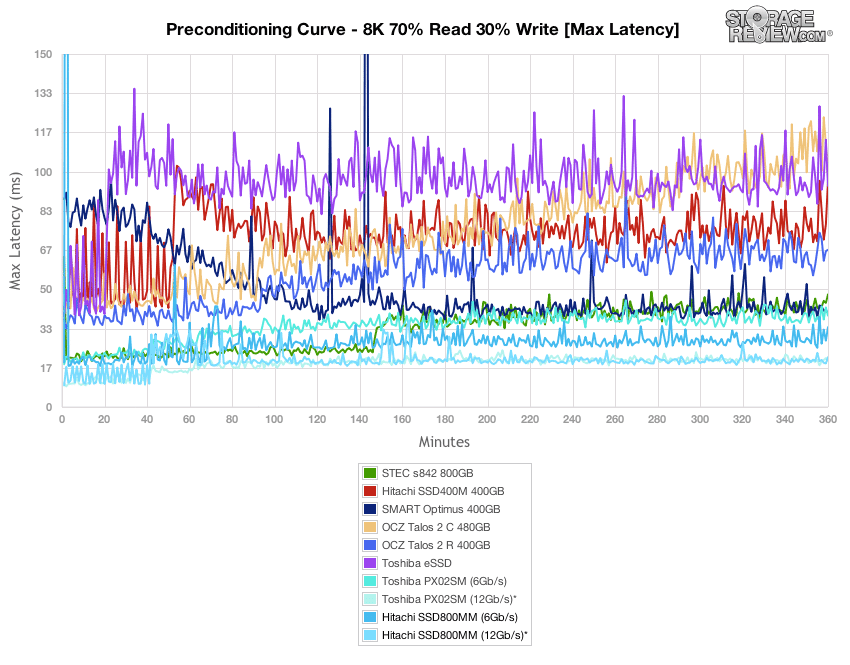
The HGST Ultrastar SSD800MM 12Gb/s latency consistency performed the best offering less than half that of the 6Gb/s, and it was able to fend off the Toshiba PX02SM 12Gb/s too.
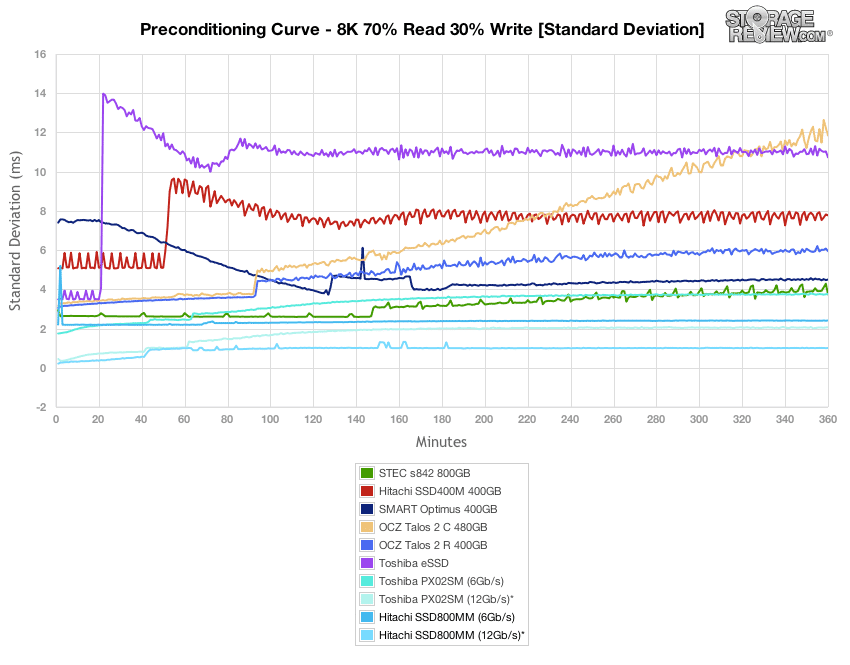
Compared to the fixed 16 thread, 16 queue max workload we performed in the 100% 4k write test, our mixed workload profiles scale the performance across a wide range of thread/queue combinations. In these tests, we span workload intensity from 2 threads and 2 queue up to 16 threads and 16 queue. In the expanded 8k 70/30 test, the HGST Ultrastar SSD800MM 12Gb/s peaked at 63,000+ IOPS which was at the top of the group by a significant margin along with the 6Gb/s which was about 10,000 IOPS lower. The Toshiba PX02SM 12Gb/s held very little advantage over its 6Gb/s testing.
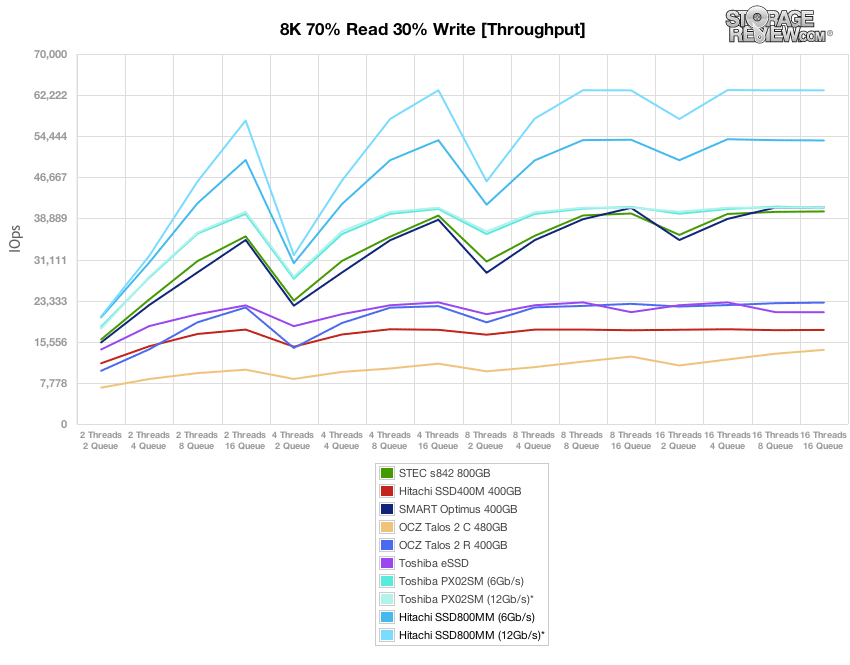
Average latency for the HGST Ultrastar SSD800MM 12Gb/s was class-best. It didn’t have a great advantage over the 6Gb/s, but did provide a small delta nonetheless. The Toshiba PX02SM provided no noticeable delta.
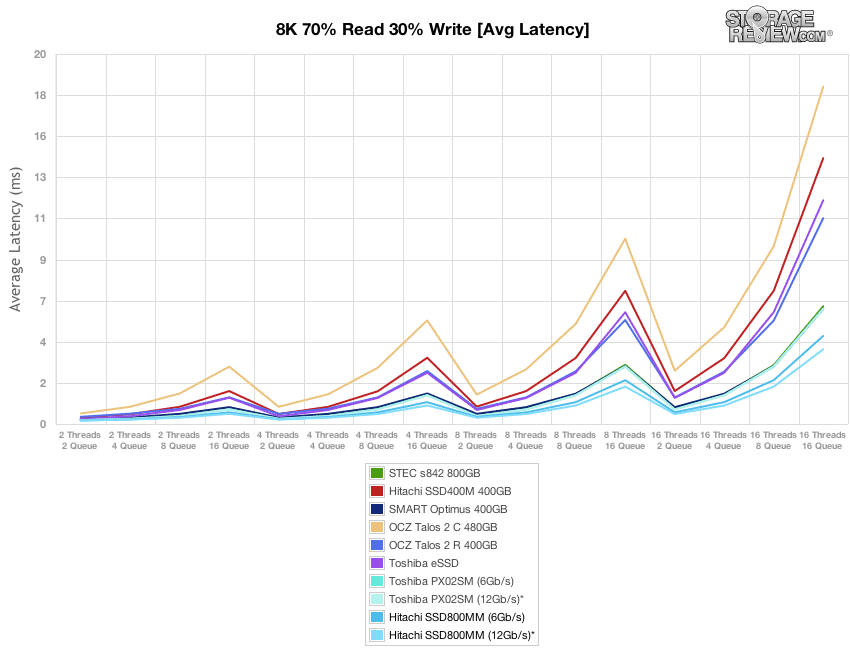
Over the duration of our varying load 8k 70/30 test, max latency stayed very low from the HGST Ultrastar SSD800MM 12Gb/s with the peak staying under 20ms for the bulk of the test until the terminal queue depth. It jumped very slightly to 21.73ms with the highest 16T/16Q load, which was still the lowest peak amongst the SSDs, edging out the Toshiba PX02SM 12Gb/s. The 12Gb/s testing yielded about half of the latency of the 6Gb/s.
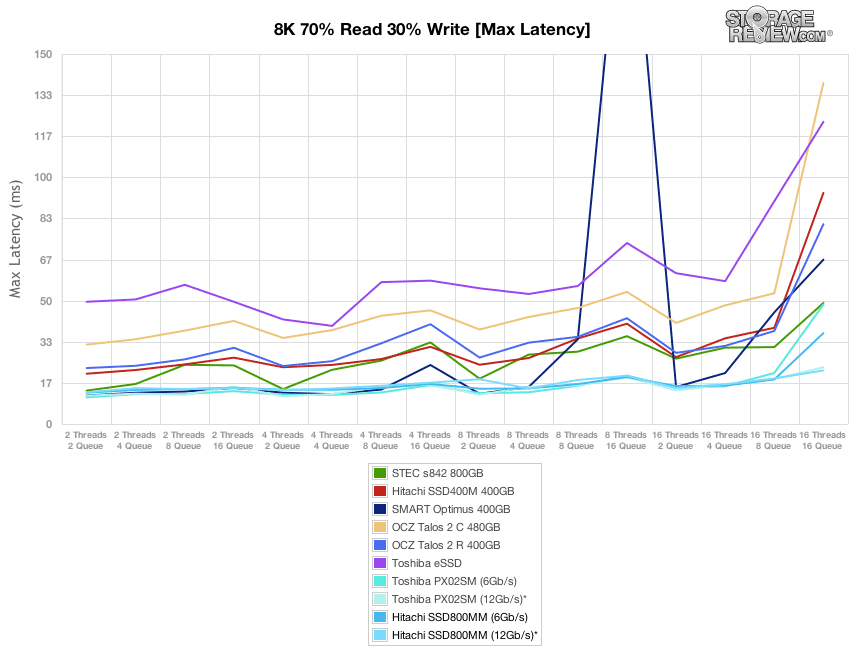
Standard deviation provided similar results to the previous max latency test with the HGST Ultrastar SSD800MM 12Gb/s again coming out on top in our test environment. 12Gb/s figures display about half the latency of that from the 6Gb/s.
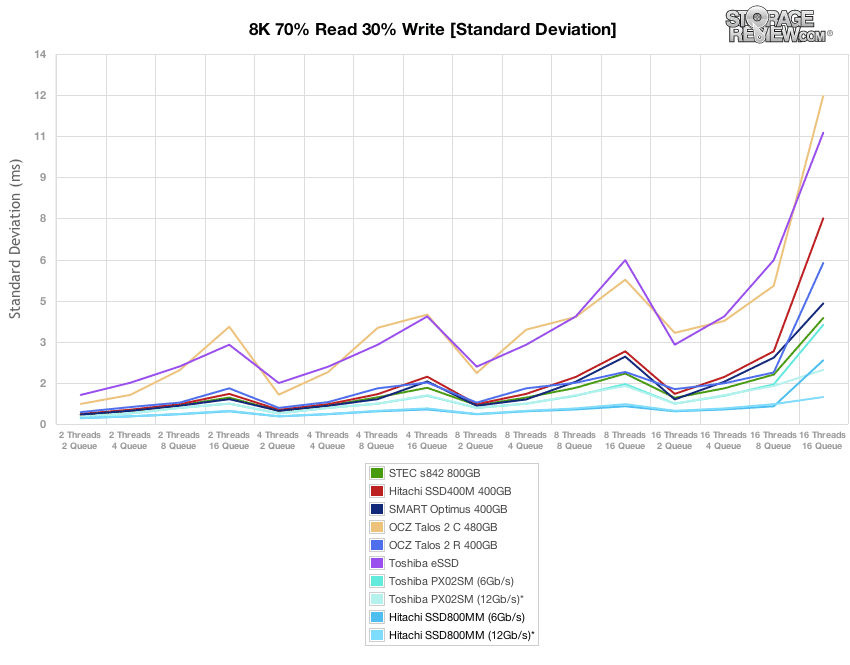
Conclusion
The HGST Ultrastar SSD800MM maxes out at 800GB, features low power consumption at just 11W/9W (customizable), and most significantly is just the second drive on the market to feature the new 12Gb/s SAS interface. The SSD800MM also features co-developed Intel/HGST controllers and 25nm MLC NAND. Along with its mainstream and more entry-level siblings, the SSD800MM is designed to handle workloads with the most performance-heavy requirements such as big data analytics, high-frequency trading, online banking and cloud computing. HGST is also shipping these drives in different flavors of encryption for even greater customization of data security.
When it came time to test the HGST Ultrastar SSD800MM using our 4k and 8k synthetic benchmark tests, the SSD800MM delivered outstanding performance. With just one exception, it provided the greatest throughput and the least latency of any comparable drive. Going a step further, its throughput was tens of thousands of IOPS ahead of the competition, and its latency was rarely matched, though the Toshiba kept pace in max latency and standard deviation. The only area in which the SSD800MM performed below the number one spot was in 4k max latency in which it fell to the back of the group in read activity and the middle for write activity.
With such incredible performance out of the HGST drive it’s somewhat frustrating to have such a limited sample size in terms of number of drives and no production ready HBAs with full driver support. Further driving the point this is very early in the SAS 12Gb/s maturity stage is the cabling harness, which no enterprise in their right mind would deploy, or possibly be able to deploy with all server chassis opting instead for integrated SAS backplanes. Alternatively LSI could have used an external Mini SAS HD x4 (SFF-8644) to Mini SAS x4 (SFF-8088) cable to provide more standard access for server platforms, though others evaluating this technology utilize workstation platforms instead of servers. Whatever the case and no matter how you get there, Linux support is severely lacking at this point which in addition to the lack of proven HBA options makes adoption of the HGST drive improbable until supporting products hit full production status.
When the ecosystem is more developed however, the HGST drive should show itself ready for prime time. Unfortunately the other SAS 12Gb/s offering in the space from Toshiba can’t quite be so bold. In this review when we put it to work on the LSI SAS 12 HBA, the Toshiba PX02SM showed small gains, but overall performance stayed roughly the same to how the product performed in a legacy SAS 6 environment. Much of this comes down to engineering, HGST and Intel have co-developed a fantastic controller that continues to grow where others are quickly getting left behind.
Pros
- 4k and 8k synthetic benchmark testing marks are far superior to comparables
- Performance gained from 12Gb/s nearly across the board in synthetic testing
Cons
- Maximum capacity limited to 800GB
- Performance limited by HBA solutions available
Bottom Line
The HGST Ultrastar SSD800MM may be the second 12Gb/s SAS SSD to hit the market, but its performance really makes a splash. In fact, the HGST SSD800MM sets a new standard of performance for SAS SSDs, boasting tremendous throughput numbers in Windows.
HGST Ultrastar SSD800MM Product Page
UPDATE 2/13/2014 – HGST SSD80MM Review Updated with SAS3 Platform




 Amazon
Amazon